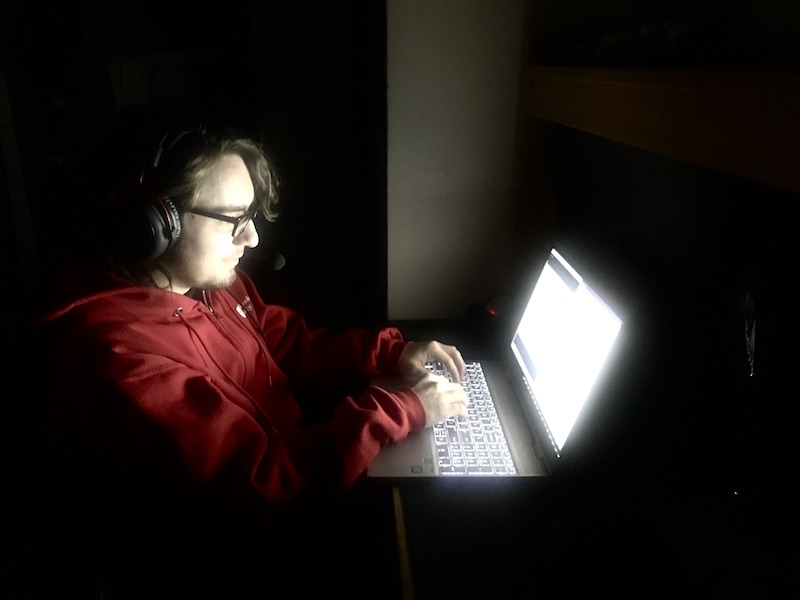School supplies, a monitor and food fill the surface of the wooden desk where Salvatore Leone spends the majority of his time. He is, after all, a student at Stony Brook University in New York and is finding that screens dominate his life.
“I currently spend most of the day on my computer,” said Leone, a sophomore computer science major. “I used my computer daily to play games, watch movies and do homework.”
Leone isn’t alone. Millions of students in the United States from those in preschool to those in doctoral programs are spending more time in front of a screen. COVID-19 drove them there, and it likely appears that they will stay there deep into 2021 which has optometrists worried about potential permanent eye damage.
Personal computers became as common as textbooks in the 1990s with the rise of the internet. In the 2000s, other devices such as smartphones and tablets joined in, creating an increase of screen time.
Now, virtual learning has added video conferencing applications such as Zoom that keep students glued to their screens each day for even more hours than usual. And that doesn’t include idle time spent doomscrolling on Twitter or playing video games.
“Student-age (people) … (do) a lot of screen time anyhow,” said Dr. Thomas Conrod, an optometrist at Hamden Eye Associates in Hamden, Connecticut. “But at least, while all the time you were in classes, you were sitting in a class, and you’re at least 10 to 15 feet away from what you’re looking at most of the time even though you might have a device in your room to take notes.
“Now, all of a sudden, you’re going from that to, in some cases, 100% classwork on a computer. So, not only are you doing all your normal time up close, but now all your class time is focusing at an 18-inch-to-24-inch range as well.”

The constant glare of the screen causes more blue-light exposure. That can lead to computer vision syndrome, a form of strain that can cause headaches, blurred vision and dry eyes, according to an article from the American Optometric Association.
Blue-light rays, also known as high-energy visible light rays, have the shortest wavelengths yet the highest amount of energy. They’re present most significantly in the sun but because screen time has increased and students generally sit close to the device, optometrists fear long-term effects to the human eye, according to an article by Dr. Gary Heiting on allaboutvision.com.
Conrod said that studies on how much blue light can damage the eye have yet to be published, meaning the extent of the damage — known now anecdotally — is unknown. That can be dangerous.
“So far, there isn’t any research that suggests that our devices are doing things like causing cancer in our eyes or causing physical damage to the surfaces of our eyes like the ultra violet (UV) light can from sun exposure,” Conrod said. “But there are different reasons why blue light can impact our eyes.”
Seven Chinese doctors performed a study that confirmed that long-term blue-light exposure resulted in retinal ganglion cells (RGC-5) deaths. The study, which was published in Apoptosis, an international peer-reviewed journal focused on cell death, in March 2014, also noted the RGC-5’s morphological changes and decreased viability.
Aside from digital eye strain, blue light affects the circadian rhythm, also known as the sleep cycle. Blue light wakes the body up, hence its presence in sunlight. That said, too much blue light at night will keep one awake, leading to poor sleeping patterns.
Leone, for one, said he feels more anxious than ever.
The increase in use of technology has honestly killed my motivation to learn and my grades are lower now than my two previous semesters.
Salvatore Leone, Stony Brook University student
“Lectures are not as enjoyable anymore as I do not feel like I’m actually a part of a learning environment,” Leone said. “It’s hard to focus and actually comprehend what is being taught.”
Jonathan Pelto, a part-time faculty member at Quinnipiac University in Hamden, is teaching his inaugural First-Year Seminar (FYS) course this fall and has seen this trend among his students. The course is designed to encourage discussion, but that seldom occurs, Pelto said.
“For the discussion, it is virtually nonexistent,” Pelto said. “And considering the whole purpose, or a primary purpose, of FYS was to get students to understand that at the college level their participation is an important part of the experience in the classroom, I feel like that field is slipping.”
Pelto, who also teaches the Elections and Political Parties course, said his students also do not participate, thus making it difficult for him to interact and build relationships with his students.
Jared Schauer, a senior 3+1 advertising and integrated communications major at Quinnipiac, said his anxiousness has risen since the beginning of the fall semester when classes resumed. Even with his escalated anxiety, though, Schauer said he doesn’t manage his screen time which reaches upwards of 12 hours.
Yet even then, Schauer may find it hard to disconnect as the screens carry so much of daily life interactions such as texting, shopping and catching up with news feeds on social media. Conrod suggested that Schauer and his classmates try to focus on non-screen surfaces for 20 seconds every 20 minutes and consistently blink.
“When people are staring and concentrating and focusing, we don’t tend to blink that much,” Conrod said. “Sometimes you have to make a concerted effort to blink. Our eyelids are like windshield wipers, and they redistribute tear film which helps keep the surface of our cornea — like the windshield — healthy.”
In addition to blinking a lot, wearing blue-light glasses can help block some of the light, so that one’s circadian rhythm is not disturbed, according to a peer-reviewed article in Chronobiology International written by eight Japanese doctors.

Jess Brij-Raj, a sophomore media studies and public relations major at Quinnipiac, bought a pair to combat dry eyes and headaches. Additionally, she exercises and goes outside to avoid screen usage during the day. At night, she puts her devices down and reads for an hour before bed.
Still, she found herself anxious and stressed and said her mental health has been worse since beginning school this year.
“I am not as driven as I was before,” Brij-Raj said. “It is hard to motivate myself to do an assignment on my laptop after I’ve been staring at my screen for the whole day.”
Like Brij-Raj, Schauer has lacked motivation in class. He said he’s lucky that his grades stayed the same but witnessed his friends’ grades drop.
“As far as my drive and enjoyment, I’m usually very self motivated and enjoy school,” Schauer said. “But I’ve found myself just coasting through classes and not really enjoying them.”
Classes, as Pelto mentioned, are far less interactive and students often have their cameras turned off unless a professor requires it to be on. He said the current technology, although important for education, is not beneficial for participation. So, Pelto adjusted. He no longer gives tests and allows students to submit papers as PowerPoint presentations instead of lengthy, formal textual documents.
“So, in that case, the technology is actually helping me I think reach students better, or I’m trying to accommodate students in ways that I hadn’t before,” Pelto said. “But I do not think I’m doing anything to address the health-related issues of too much screen time.”
Pelto said that since being overexposed to blue light is a relatively new concern, most teachers from elementary to collegiate levels haven’t addressed it. He said he believes once the issue is more apparent and better understood, teachers will create mechanisms to help manage it.
“When people hear about excessive amounts of screen time, they often think of children watching too much TV or now playing games too much,” Pelto said.
Remote learning will be central to American education until the COVID-19 pandemic eases. Teaching protocols may change to combat the potential of long-term eye damage among faculty and students.
“I wouldn’t be surprised at all if in a year or two, we start seeing academic scholarly journals on the actual physical and mental health impacts of the screen time, whether it’s due to the light issue that you’re addressing or simply due to the way in which the educational experience takes place now,” Pelto said.
Until then, Leone said he will use blue-light filters on his devices as the semester comes to a close. He also said he will detach from his screen when the semester ends in December.
“I want to use the computer less because it’s supposed to be something to enjoy,” Leone said. “If I also use it to attend class and do all my work constantly, it loses that value as entertainment to me. It starts to feel like I’m stuck on it all day, rather than on it voluntarily.”

